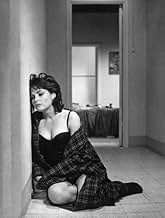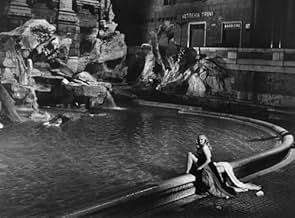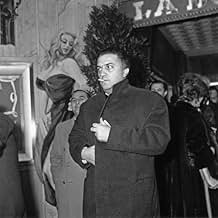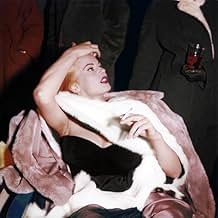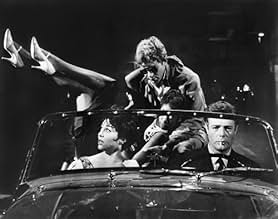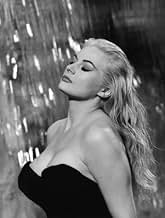Una serie de historias que siguen una semana en la vida de un periodista paparazzo que vive en Roma.Una serie de historias que siguen una semana en la vida de un periodista paparazzo que vive en Roma.Una serie de historias que siguen una semana en la vida de un periodista paparazzo que vive en Roma.
- Dirección
- Guionistas
- Elenco
- Ganó 1 premio Óscar
- 11 premios ganados y 12 nominaciones en total
Anouk Aimée
- Maddalena
- (as Anouk Aimee)
Magali Noël
- Fanny
- (as Magali Noel)
Resumen
Reviewers say 'La Dolce Vita' delves into themes of fame, decadence, and the superficiality of celebrity culture, using these characters to underscore the contrasts and contradictions within high society. The portrayal of it's characters enhances the film's satirical and critical perspective on the lifestyles and attitudes of the era, offering a nuanced commentary on the nature of fame and its impact on individuals and society.
Opiniones destacadas
Marcello Rubini (Marcello Mastroianni) is a man-about-town and a gossip journalist in Rome. His girlfriend Emma overdoses and recovers. Swedish-American bombshell Sylvia (Anita Ekberg) arrives and hangs out with Marcello while the Paparazzo hounds them. Her boyfriend Robert gets angry and hits him. As his series of adventures continue, there is an emptiness to it all and a meaninglessness to his life.
This iconic film has a disjointed narrative structure. It has many sections without the connective tissue. It's a tough watch especially for a three hour movie. It's exhilarating for a long time but it gets tiring by the end. The sad emptiness infects the viewing experience. The lifestyle is thoroughly modern celebrity world. The thrill disapates. Its iconic nature deserves extra points, but this is strictly for film fans.
This iconic film has a disjointed narrative structure. It has many sections without the connective tissue. It's a tough watch especially for a three hour movie. It's exhilarating for a long time but it gets tiring by the end. The sad emptiness infects the viewing experience. The lifestyle is thoroughly modern celebrity world. The thrill disapates. Its iconic nature deserves extra points, but this is strictly for film fans.
Federico Fellini's "La Dolce Vita" transcends the boundaries of conventional cinema, presenting itself as an immersive odyssey that delves into the decadence of Rome's privileged class amidst Italy's post-war economic resurgence. It offers a poignant discourse on the complexities of human existence, woven into the fabric of its narrative.
The film, shot beautifully in black and white, unfolds over seven decadent and disjointed episodes. At its center is Marcello Rubini (played by Marcello Mastroianni), a hedonistic journalist who navigates the labyrinth of Rome's high society, constantly torn between the pursuit of serious literature and the allure of trivial journalism. The episodic structure allows Fellini to weave a rich tapestry of characters and incidents, all of which add to the decadence and the gradual moral decline that is "la dolce vita".
One cannot talk about "La Dolce Vita" without mentioning its iconic Trevi Fountain scene. Anita Ekberg, playing the vivacious actress Sylvia, steps into the fountain with complete abandon, and in doing so, becomes the embodiment of a carefree, unattainable ideal. Marcello's attempts to join her and his eventual failure is symbolic of his constant struggle to attain fulfillment, mirroring the film's larger theme of the fruitless pursuit of happiness in a world that equates it with decadence.
Fellini cleverly uses a blend of surrealism and neo-realism to convey the superficial allure of the hedonistic lifestyle. The luxurious parties, the flippant attitudes, and the grandeur of Rome itself are contrasted starkly with the characters' internal void and loneliness. This duality is personified in Marcello, whose transformation from an ambitious writer to a frivolous gossip columnist is both tragic and unsettling.
The most remarkable aspect of "La Dolce Vita" is arguably the poignant ending. Marcello, now a part of the world he once viewed with a mix of fascination and contempt, witnesses a grotesque sea creature being hauled onto the shore. The creature, monstrous and out of place, symbolizes the death of innocence and Marcello's final surrender to the 'sweet life'. The ending of this story is left unresolved, provoking us to contemplate our own quests for contentment. The feeling of emptiness and hollowness it incites makes us think deeply about our pursuit of happiness.
One must not overlook Fellini's mastery over the medium of cinema when discussing "La Dolce Vita". His stylistic prowess, characterized by long, meandering takes and a persistent undertone of surrealism, encapsulates the viewer in the film's world. The cinematography elegantly captures the splendor and squalor of Rome, while its iconic score by Nino Rota perfectly complements the visual narrative. Together, they create an immersive atmosphere that blurs the boundary between reality and illusion, much like the lives of the characters on screen.
Furthermore, Fellini's use of religious and mythological symbolism adds a layer of depth to the narrative. He draws parallels between Marcello's journey and Dante's "Divine Comedy," subtly suggesting a descent into a modern, urban Hell characterized by superficiality and debauchery. Iconic scenes, like the statue of Christ being flown over Rome, bring a sense of irony and critique, underscoring the clash between traditional values and the emerging, materialistic culture.
The film's ensemble cast is worth noting, each bringing their character to life with stunning authenticity. The performances are all commendable, but it is Marcello Mastroianni's nuanced portrayal of Marcello that truly anchors the film. Mastroianni embodies the charisma and inner conflict of his character with such finesse that his struggles become palpable, and his moral decline is both believable and deeply affecting.
Moreover, Fellini takes a critical look at the role of media, a theme that feels incredibly relevant even today. Marcello's journalistic exploits are shown as invasive and unethical, often leading to tragic outcomes. The film takes jabs at the sensationalism that often overshadows the pursuit of truth in journalism, highlighting how it contributes to the moral degradation of society.
Overall, "La Dolce Vita" goes beyond its surface-level portrayal of a glamorous yet hollow lifestyle. It serves as a cautionary tale, a sociopolitical critique, and a philosophical exploration of life's meaning. Fellini's deft handling of complex themes and his innovative narrative and visual techniques have cemented "La Dolce Vita" as an enduring piece of cinematic art. It is not just a film, but a mirror held up to society, reflecting its allure and its flaws with equal clarity.
In the pantheon of cinematic masterpieces, Fellini's "La Dolce Vita" stands as a timeless testament to the power of storytelling. It skillfully interweaves a tale of moral struggle, societal critique, and philosophical exploration of life's meaning in a changing world, with Marcello Mastroianni's tour de force performance at its heart.
Fellini's stylistic mastery over the medium, marked by long, wandering takes and a subtle undertone of surrealism, engulfs the viewer in the film's world. The splendor and squalor of Rome are captured elegantly by the cinematography, mirrored by Nino Rota's iconic score, which provides an aural landscape as complex and compelling as the visual one. Together, they generate an atmospheric blur between reality and illusion, echoing the lives of the characters within.
It is within this context that Marcello Mastroianni delivers a captivating performance. As Marcello Rubini, Mastroianni becomes a figure emblematic of modern dilemmas - a man torn between professional ambition and personal ennui, between hedonistic pleasure and spiritual fulfillment. His nuanced performance creates a Marcello who is at once charismatic and confounding, inviting both empathy and critique from the audience. Mastroianni's finesse in embodying this inner conflict and moral decline anchors the film, making Marcello's struggles palpable and his eventual descent into emptiness deeply affecting.
Fellini's profound use of religious and mythological symbolism further deepens the narrative. References to Dante's "Divine Comedy" subtly draw a parallel between Marcello's journey and a descent into a modern, urban Hell defined by superficiality and moral decay. Ironical images, like the statue of Christ flown over Rome, underscore the clash between traditional values and the emerging culture of materialism.
Not to be overlooked is Fellini's sharp critique of media's role. Portraying Marcello's journalistic ventures as intrusive and unethical, the film highlights the potentially damaging effects of sensationalism overshadowing the pursuit of truth - a commentary that remains remarkably relevant today.
"La Dolce Vita" thus transcends its portrayal of a glitzy yet hollow lifestyle to deliver a cautionary tale that resonates on multiple levels. The film's enduring appeal lies not only in Fellini's innovative narrative and visual techniques but also in the strength of performances, most notably Mastroianni's. In its entirety, "La Dolce Vita" remains not just a film, but a reflective surface for society, casting both its allure and its flaws into sharp relief.
In conclusion, Fellini's "La Dolce Vita" is a timeless masterpiece. It masterfully intertwines imagery, symbolism, and narrative to create a commentary on the emptiness of excess and the illusion of fulfillment. This movie does more than just entertain; it encourages deep thinking and introspection, making it a truly one-of-a-kind experience. Its capacity to stimulate meaningful thinking is its true strength. It takes you on an exploration into humanity's innermost motivations and dissatisfactions.
The film, shot beautifully in black and white, unfolds over seven decadent and disjointed episodes. At its center is Marcello Rubini (played by Marcello Mastroianni), a hedonistic journalist who navigates the labyrinth of Rome's high society, constantly torn between the pursuit of serious literature and the allure of trivial journalism. The episodic structure allows Fellini to weave a rich tapestry of characters and incidents, all of which add to the decadence and the gradual moral decline that is "la dolce vita".
One cannot talk about "La Dolce Vita" without mentioning its iconic Trevi Fountain scene. Anita Ekberg, playing the vivacious actress Sylvia, steps into the fountain with complete abandon, and in doing so, becomes the embodiment of a carefree, unattainable ideal. Marcello's attempts to join her and his eventual failure is symbolic of his constant struggle to attain fulfillment, mirroring the film's larger theme of the fruitless pursuit of happiness in a world that equates it with decadence.
Fellini cleverly uses a blend of surrealism and neo-realism to convey the superficial allure of the hedonistic lifestyle. The luxurious parties, the flippant attitudes, and the grandeur of Rome itself are contrasted starkly with the characters' internal void and loneliness. This duality is personified in Marcello, whose transformation from an ambitious writer to a frivolous gossip columnist is both tragic and unsettling.
The most remarkable aspect of "La Dolce Vita" is arguably the poignant ending. Marcello, now a part of the world he once viewed with a mix of fascination and contempt, witnesses a grotesque sea creature being hauled onto the shore. The creature, monstrous and out of place, symbolizes the death of innocence and Marcello's final surrender to the 'sweet life'. The ending of this story is left unresolved, provoking us to contemplate our own quests for contentment. The feeling of emptiness and hollowness it incites makes us think deeply about our pursuit of happiness.
One must not overlook Fellini's mastery over the medium of cinema when discussing "La Dolce Vita". His stylistic prowess, characterized by long, meandering takes and a persistent undertone of surrealism, encapsulates the viewer in the film's world. The cinematography elegantly captures the splendor and squalor of Rome, while its iconic score by Nino Rota perfectly complements the visual narrative. Together, they create an immersive atmosphere that blurs the boundary between reality and illusion, much like the lives of the characters on screen.
Furthermore, Fellini's use of religious and mythological symbolism adds a layer of depth to the narrative. He draws parallels between Marcello's journey and Dante's "Divine Comedy," subtly suggesting a descent into a modern, urban Hell characterized by superficiality and debauchery. Iconic scenes, like the statue of Christ being flown over Rome, bring a sense of irony and critique, underscoring the clash between traditional values and the emerging, materialistic culture.
The film's ensemble cast is worth noting, each bringing their character to life with stunning authenticity. The performances are all commendable, but it is Marcello Mastroianni's nuanced portrayal of Marcello that truly anchors the film. Mastroianni embodies the charisma and inner conflict of his character with such finesse that his struggles become palpable, and his moral decline is both believable and deeply affecting.
Moreover, Fellini takes a critical look at the role of media, a theme that feels incredibly relevant even today. Marcello's journalistic exploits are shown as invasive and unethical, often leading to tragic outcomes. The film takes jabs at the sensationalism that often overshadows the pursuit of truth in journalism, highlighting how it contributes to the moral degradation of society.
Overall, "La Dolce Vita" goes beyond its surface-level portrayal of a glamorous yet hollow lifestyle. It serves as a cautionary tale, a sociopolitical critique, and a philosophical exploration of life's meaning. Fellini's deft handling of complex themes and his innovative narrative and visual techniques have cemented "La Dolce Vita" as an enduring piece of cinematic art. It is not just a film, but a mirror held up to society, reflecting its allure and its flaws with equal clarity.
In the pantheon of cinematic masterpieces, Fellini's "La Dolce Vita" stands as a timeless testament to the power of storytelling. It skillfully interweaves a tale of moral struggle, societal critique, and philosophical exploration of life's meaning in a changing world, with Marcello Mastroianni's tour de force performance at its heart.
Fellini's stylistic mastery over the medium, marked by long, wandering takes and a subtle undertone of surrealism, engulfs the viewer in the film's world. The splendor and squalor of Rome are captured elegantly by the cinematography, mirrored by Nino Rota's iconic score, which provides an aural landscape as complex and compelling as the visual one. Together, they generate an atmospheric blur between reality and illusion, echoing the lives of the characters within.
It is within this context that Marcello Mastroianni delivers a captivating performance. As Marcello Rubini, Mastroianni becomes a figure emblematic of modern dilemmas - a man torn between professional ambition and personal ennui, between hedonistic pleasure and spiritual fulfillment. His nuanced performance creates a Marcello who is at once charismatic and confounding, inviting both empathy and critique from the audience. Mastroianni's finesse in embodying this inner conflict and moral decline anchors the film, making Marcello's struggles palpable and his eventual descent into emptiness deeply affecting.
Fellini's profound use of religious and mythological symbolism further deepens the narrative. References to Dante's "Divine Comedy" subtly draw a parallel between Marcello's journey and a descent into a modern, urban Hell defined by superficiality and moral decay. Ironical images, like the statue of Christ flown over Rome, underscore the clash between traditional values and the emerging culture of materialism.
Not to be overlooked is Fellini's sharp critique of media's role. Portraying Marcello's journalistic ventures as intrusive and unethical, the film highlights the potentially damaging effects of sensationalism overshadowing the pursuit of truth - a commentary that remains remarkably relevant today.
"La Dolce Vita" thus transcends its portrayal of a glitzy yet hollow lifestyle to deliver a cautionary tale that resonates on multiple levels. The film's enduring appeal lies not only in Fellini's innovative narrative and visual techniques but also in the strength of performances, most notably Mastroianni's. In its entirety, "La Dolce Vita" remains not just a film, but a reflective surface for society, casting both its allure and its flaws into sharp relief.
In conclusion, Fellini's "La Dolce Vita" is a timeless masterpiece. It masterfully intertwines imagery, symbolism, and narrative to create a commentary on the emptiness of excess and the illusion of fulfillment. This movie does more than just entertain; it encourages deep thinking and introspection, making it a truly one-of-a-kind experience. Its capacity to stimulate meaningful thinking is its true strength. It takes you on an exploration into humanity's innermost motivations and dissatisfactions.
LA DOLCE VITA presents a series of incidents in the life of Roman tabloid reporter Marcello Rubini (Marcello Mastroianni)--and although each incident is very different in content they create a portrait of an intelligent but superficial man who is gradually consumed by "the sweet life" of wealth, celebrity, and self-indulgence he reports on and which he has come to crave.
Although the film seems to be making a negative statement about self-indulgence that leads to self-loathing, Fellini also gives the viewer plenty of room to act as interpreter, and he cleverly plays one theme against its antithesis throughout the film. (The suffocation of monogamy vs. the meaninglessness of promiscuity and sincere religious belief vs. manipulative hypocrisy are but two of the most obvious juxtapositions.) But Fellini's most remarkable effect here is his ability to keep us interested in the largely unsympathetic characters LA DOLCE VITA presents: a few are naive to the point of stupidity; most are vapid; the majority (including the leads) are unspeakably shallow--and yet they still hold our interest over the course of this three hour film.
The cast is superior, with Marcello Mastroianni's personal charm particularly powerful. As usual with Fellini, there is a lot to look at on the screen: although he hasn't dropped into the wild surrealism for which he was sometimes known, there are quite a few surrealistic flourishes and visual ironies aplenty--the latter most often supplied by the hordes of photographers that scuttle after the leading characters much like cockroaches in search of crumbs. For many years available to the home market in pan-and-scan only, the film is now in a letterbox release that makes it all the more effective. Strongly recommended.
Gary F. Taylor, aka GFT, Amazon Reviewer
Although the film seems to be making a negative statement about self-indulgence that leads to self-loathing, Fellini also gives the viewer plenty of room to act as interpreter, and he cleverly plays one theme against its antithesis throughout the film. (The suffocation of monogamy vs. the meaninglessness of promiscuity and sincere religious belief vs. manipulative hypocrisy are but two of the most obvious juxtapositions.) But Fellini's most remarkable effect here is his ability to keep us interested in the largely unsympathetic characters LA DOLCE VITA presents: a few are naive to the point of stupidity; most are vapid; the majority (including the leads) are unspeakably shallow--and yet they still hold our interest over the course of this three hour film.
The cast is superior, with Marcello Mastroianni's personal charm particularly powerful. As usual with Fellini, there is a lot to look at on the screen: although he hasn't dropped into the wild surrealism for which he was sometimes known, there are quite a few surrealistic flourishes and visual ironies aplenty--the latter most often supplied by the hordes of photographers that scuttle after the leading characters much like cockroaches in search of crumbs. For many years available to the home market in pan-and-scan only, the film is now in a letterbox release that makes it all the more effective. Strongly recommended.
Gary F. Taylor, aka GFT, Amazon Reviewer
I first saw this movie probably over 25 years ago when I was quite a bit younger. At that point I enjoyed it for its party scenes, sense of joy and life and vitality and....Marcello Mastroianni. Now that I'm older myself and have just recently seen the movie again, I find that I have a much deeper understanding of it. Maybe it takes some age to find some meaning. In a nutshell, Marcello is at a crossroads in his life, he's unable to settle down or move foreward into any direction - he's a diletante with aspirations but no real goals. He's wrapped up in himself and in projecting rather dreamy ideals onto other people. But as he keeps projecting on to others he comes to find in each situation that he doesn't really know the person and they are a mystery and probably a disappointment to him. certainly steiner is the biggest disappointment and disillusions him to a degree that he is apparently lost to a life of corruption and decadence as a result. but it's not that these people are difficult to understand to someone other than marcello - i think we can see that anita ekberg's character really is just a big good-natured blond and not the mysterious goddess marcello makes her out to be; his father is again - the typical traveling salesman and perhaps not the paternal figure that marcello would like him to be. his amour maddelena lives up to her name even as marcello starts believing himself in love with her - he's literally seduced by nothing more than an image he creates in his own mind. his friend steiner seems to have it all to marcello and to be the renaissance man that he would like to be - but, of course, he is dissatisfied and disturbed and we see what the end is. the only one whom marcello forms a somewhat realistic connection with is his girlfriend whom he treats badly and neglects despite her obvious love for him. he refuses to actually work on the one relationship that he could actually succeed at - he would rather dream about possibilities than actualize something.
marcello cannot communicate with others because he cannot see them as the people they really are - he just sees them as projections of his own needs, aspirations, desires and goals. when he finds out what they're really like, he either turns away or falls apart. this is an outstanding movie - 10 out of 10 and beautifully photographed. if you don't get it now, try again in 10 years - it will wait for you to catch up.
marcello cannot communicate with others because he cannot see them as the people they really are - he just sees them as projections of his own needs, aspirations, desires and goals. when he finds out what they're really like, he either turns away or falls apart. this is an outstanding movie - 10 out of 10 and beautifully photographed. if you don't get it now, try again in 10 years - it will wait for you to catch up.
Mostly because of the terrific high contrast, B&W visuals, and the evocative music, this is the only Fellini film I have seen that I have somewhat enjoyed. I recommend it, but not without reservations. It's a complex film with many textured layers of meaning. And, in typical Fellini fashion, it rambles and it meanders.
Deviating from standard three-Act structure, Fellini's story consists of roughly eight episodes, all starting at night and ending at dawn, more or less. Each has its own crisis. And the only thing that unites these episodes into a coherent whole is the story's protagonist, Marcello (Marcello Mastroianni). In his job as a journalist and overall observer of human nature, Marcello encounters people in high society who seem outwardly happy and self-fulfilled. On closer examination, however, these people are empty, hollow, alienated, emotionally adrift and vacant.
A good example is the starlet Sylvia (Anita Ekberg), a glamorous figure, but she's all image and no substance. "La dolce vita" is the first film that uses the concept of "paparazzi", which implies the importance of "image", separate from substance.
Throughout the various episodes Marcello sees these "images" of happiness, of contentment, but the images are deceptive, elusive, unreliable. In one episode, two "miracle" children "see" the Madonna. "The Madonna is over there", shouts one child. The crowd chases after her. But the other child who "sees" the Madonna runs in the opposite direction. Happiness, self-fulfillment, religious visions ... they're all a will-o'-the-wisp. And so, the film conveys a sense of pessimism and cynicism.
The film thus has deep thematic value. It caused a scandal when it was released, and was banned by the Catholic Church, apparently for appearing to be anti-religious.
Yet for all its deep meaning, "La dolce vita" can be a trial to sit through. Somewhere in the second half I began to lose interest. I don't have a problem with Fellini's deviation from standard plot structure. I do have a problem with a director who doesn't know when to quit. This film goes on for almost three hours. A good edit, to delete all the fat, would have tightened up the story and rendered it more potent. As is, it's too strung out, too stretched, too meandering.
If the viewer can persevere, there's enormous cinematic art in this film. And helped along by Nino Rota's music, the film is wonderfully evocative, at times stylishly melancholy.
Deviating from standard three-Act structure, Fellini's story consists of roughly eight episodes, all starting at night and ending at dawn, more or less. Each has its own crisis. And the only thing that unites these episodes into a coherent whole is the story's protagonist, Marcello (Marcello Mastroianni). In his job as a journalist and overall observer of human nature, Marcello encounters people in high society who seem outwardly happy and self-fulfilled. On closer examination, however, these people are empty, hollow, alienated, emotionally adrift and vacant.
A good example is the starlet Sylvia (Anita Ekberg), a glamorous figure, but she's all image and no substance. "La dolce vita" is the first film that uses the concept of "paparazzi", which implies the importance of "image", separate from substance.
Throughout the various episodes Marcello sees these "images" of happiness, of contentment, but the images are deceptive, elusive, unreliable. In one episode, two "miracle" children "see" the Madonna. "The Madonna is over there", shouts one child. The crowd chases after her. But the other child who "sees" the Madonna runs in the opposite direction. Happiness, self-fulfillment, religious visions ... they're all a will-o'-the-wisp. And so, the film conveys a sense of pessimism and cynicism.
The film thus has deep thematic value. It caused a scandal when it was released, and was banned by the Catholic Church, apparently for appearing to be anti-religious.
Yet for all its deep meaning, "La dolce vita" can be a trial to sit through. Somewhere in the second half I began to lose interest. I don't have a problem with Fellini's deviation from standard plot structure. I do have a problem with a director who doesn't know when to quit. This film goes on for almost three hours. A good edit, to delete all the fat, would have tightened up the story and rendered it more potent. As is, it's too strung out, too stretched, too meandering.
If the viewer can persevere, there's enormous cinematic art in this film. And helped along by Nino Rota's music, the film is wonderfully evocative, at times stylishly melancholy.
¿Sabías que…?
- TriviaThe famous scene in the Trevi Fountain was shot over a week in March, when nights were still cold. According to Federico Fellini (in an interview with Costanzo Costantini), Anita Ekberg stood in the cold water in her dress for hours with no trouble. Marcello Mastroianni, on the other hand, had to wear a wetsuit beneath his clothes, and even that wasn't enough. Still freezing, he downed an entire bottle of vodka, so he was completely drunk while shooting the scene.
- ErroresWhen Marcello and Maddalena arrive at the prostitute's apartment, a long electric cable (light?) can be seen attached to the right rear of the car, moving along until the car stops.
- Versiones alternativasIn the original American release, distributed by American International Pictures, the titles open with the AIP logo and appear over a shot of the sky with clouds. In the current release on DVD - and as shown on TCM - the title sequence is over a black background. When originally released, censors in several countries trimmed certain scenes, including the orgy near the end of the film.
- ConexionesEdited into La case du siècle: Cinecittà, de Mussolini à la Dolce Vita (2021)
Selecciones populares
Inicia sesión para calificar y agrega a la lista de videos para obtener recomendaciones personalizadas
- How long is La Dolce Vita?Con tecnología de Alexa
Detalles
- Fecha de lanzamiento
- Países de origen
- Sitio oficial
- Idiomas
- También se conoce como
- La dolce vita
- Locaciones de filmación
- Villa Giustiniani-Odescalchi, Bassano Romano, Viterbo, Lazio, Italia(abandoned castle scenes)
- Productoras
- Ver más créditos de la compañía en IMDbPro
Taquilla
- Total a nivel mundial
- USD 217,420
- Tiempo de ejecución2 horas 54 minutos
- Color
- Relación de aspecto
- 2.35 : 1
Contribuir a esta página
Sugiere una edición o agrega el contenido que falta

Principales brechas de datos
What is the streaming release date of La dulce vida (1960) in India?
Responda
![Ver Trailer [English SUB]](https://m.media-amazon.com/images/M/MV5BNjE3MTU3OTItN2I0NS00YzU2LWE1ZTctZDQ3Y2I1NDc4MGMxXkEyXkFqcGdeQXRyYW5zY29kZS13b3JrZmxvdw@@._V1_QL75_UX500_CR0)
![La Dolce Vita: [2-Disc Collectors Edition]](https://m.media-amazon.com/images/M/MV5BZTY2ZTg3YmEtZDZkMS00MmFkLThhMjItMWVmN2NlNmJhZGZjXkEyXkFqcGdeQXVyNzU1NzE3NTg@._V1_QL75_UX500_CR0)

